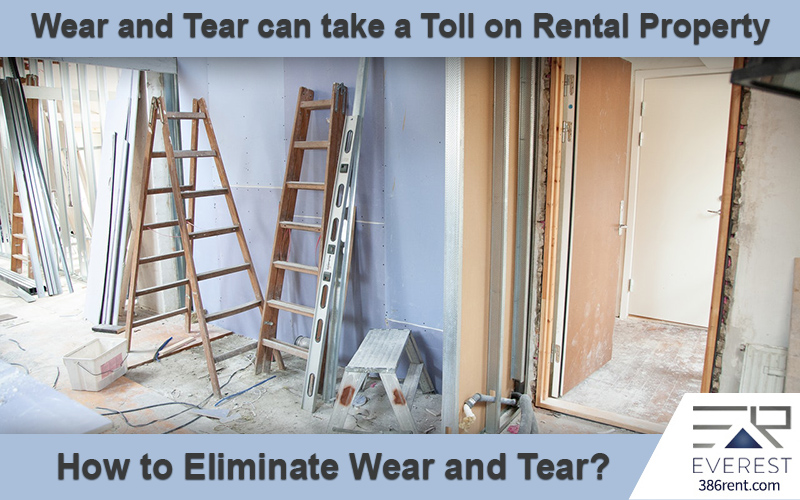Like every commodity you own, your rental or residential property also has a lifespan. It’s a fact that your personal residential property has a longer lifespan than your rental, and the simple reason for that is the amount of wear and tear on both. When we talk about a rental property, we know it changes hand either every month or year. Hence it comes under different person every so often. This means that it gets treated differently year after year. You can’t expect tenants to treat a rental as their own, they should, but they don’t. So, year after year, the rental is subjected to a lot of brutal wear and tear than your home.
Continues use of the property, renders the walls fragile, shaky foundation and soon with no or little maintenance the property can collapse. However, you can keep yours up for centuries, if you maintain it properly. The wear and tear don’t disappear, but it can be masked. Your potential tenant will not think or sympathize with you that the last tenant was bad with your rental property; he or she will not see the bad condition of the property. With excess wear and tear, the appeal of the property decreases, and so does the value. You need your property to give you adequate ROI, but with excessive wear and tear that is really hard. Here are some tips and guide to reduce wear and tear and increase the appeal of your property.
But first, it’s essential to understand the difference between wear/tear and damage.
Wear and Tear:
Wear and tear and damage are two different terms that have two different meanings.
Wear and tear refer to the slow depreciation of property over the years. This can be because of wind, water and other natural phenomena, and it is also normal and common. The way ageing happens to the body, the same way it happens to the rental; however, there are ways to limit it.
Damage:
In contrast, to wear and tear, the damage isn’t natural, it’s deliberate don’t by the tenants, their kids and pets. Tenants’ negligence and abuse can wreak havoc on your property, and that is something that a landlord shouldn’t bear. All kinds of damage are the responsibility of the tenant, and the expenses that the landlord is putting in to get it repaired should come out of the tenant’s security deposit. It’s very important that the landlords should understand how wear and tear differ from damage.
For Example:
A carpet has a life span of 5 years, but if you take good care of it, it will last you for as long as ten years. However, sunlight, foot-traffic are reasons it can lose its color, have rough patches, and all this is normal wear and tear.
However, when a negligent tenant comes in, with kids or pets, the same carpet can die in under a year. Spills, scratches and tears are all damage, and they can shorten the lifespan of carpets, furniture, etc.
Security Deposit Deduction:
We understand that the damage is the responsibility of the tenants; however, there are still some grey areas that need to be discussed.
The initial cleaning, before the turnover, is the responsibility of the landlord. However, once the tenant occupies the house, it is the responsibility of the tenant to keep it neat and clean. This may not seem like much, but when a house is not cleaned properly, the end result is a pest infestation, rodent, termite infestation, mold, fungus and what not. Sticky cabinets, lipstick stains, ruined walls are all hard to clean damages that should be the responsibility of the tenants living in the house.
Pet odor is another issue that needs to be addressed here. If you have a poorly trained pet or a smelly one like birds, you need to be mindful of the odor. It’s off-putting, and it will linger behind even when the pet leaves the house with its owner.
People who smoke, may not realize but the smoke leaves stains behind and also discolors the walls. A chain smoker as a tenant means that you will need a new paint job as soon as he or she leaves the house. All of these damages are expensive to repair, and hence the landlord is at full liberty to deduct these expenses from the tenants’ security deposit.
Pets:
The most damage that any property experiences are due to pets more than anything. Making the property pet friendly is the need of the hour. As many tenants nowadays have pets, hence you lose a significant portion of the renter’s pool if you don’t allow pets. There is a need to make your rental pet-friendly if you are switching to accepting pets.
Having pets can be very damaging, they are loud, smelly and they tend to chew on furniture, gnaw on the carpet, and their urine and poop aren’t easy to clean as well. So, in order to limit the damage, landlords can make their rentals extra pet-friendly. Apart from that, landlords can ask for a pet security deposit that will help pay for repairs of damage done by the pets.
Renters don’t mind paying high rent and extra security deposit, because in doing so they can keep their pets with them without any hassle.
Here are potential places in the house that get the most wear and tear, along with that, there are some tips and tricks to reduce it.
Rental Property’s Floor:
Pets, heavy foot-traffic can really diminish the shine off the floor, no matter which kind you have. Hence, it’s suggested that you get the most durable flooring for your rental. Vinyl, Lamination as well as hardwood flooring is not only durable; it is also pretty inexpensive.
Kitchen:
Kitchen is perhaps the most practical part of the house, oil, grease, steam and all kinds of fluids can take the shine away from the floor, walls as well as the cabinets and the counters. Go for long-lasting plastic material for countertops, rather than going for wood, as wood is hard to clean but easy to stain. To keep the shine off the walls intact, get a glossy paint job rather than a regular one, as mitigated dust and grease is easy to clean on glossy walls than matte ones.
If you’d like to talk more about property management, or you need help with Everest Property Management, please contact us at Everest Realty.




 As a top producing Realtor and Property Manager; Terry specializes in sales, extensive construction homes, rentals, REO’s, short sales, and all aspects of Real Estate. After graduating the University of Michigan with a master in MBA, Terry continued his endeavor and now has over 15+ years of experience in the Real Estate world. If there is anything that has to do with Real Estate and sales, you can always be sure of Terry to provide important, specialized knowledge.
As a top producing Realtor and Property Manager; Terry specializes in sales, extensive construction homes, rentals, REO’s, short sales, and all aspects of Real Estate. After graduating the University of Michigan with a master in MBA, Terry continued his endeavor and now has over 15+ years of experience in the Real Estate world. If there is anything that has to do with Real Estate and sales, you can always be sure of Terry to provide important, specialized knowledge.




